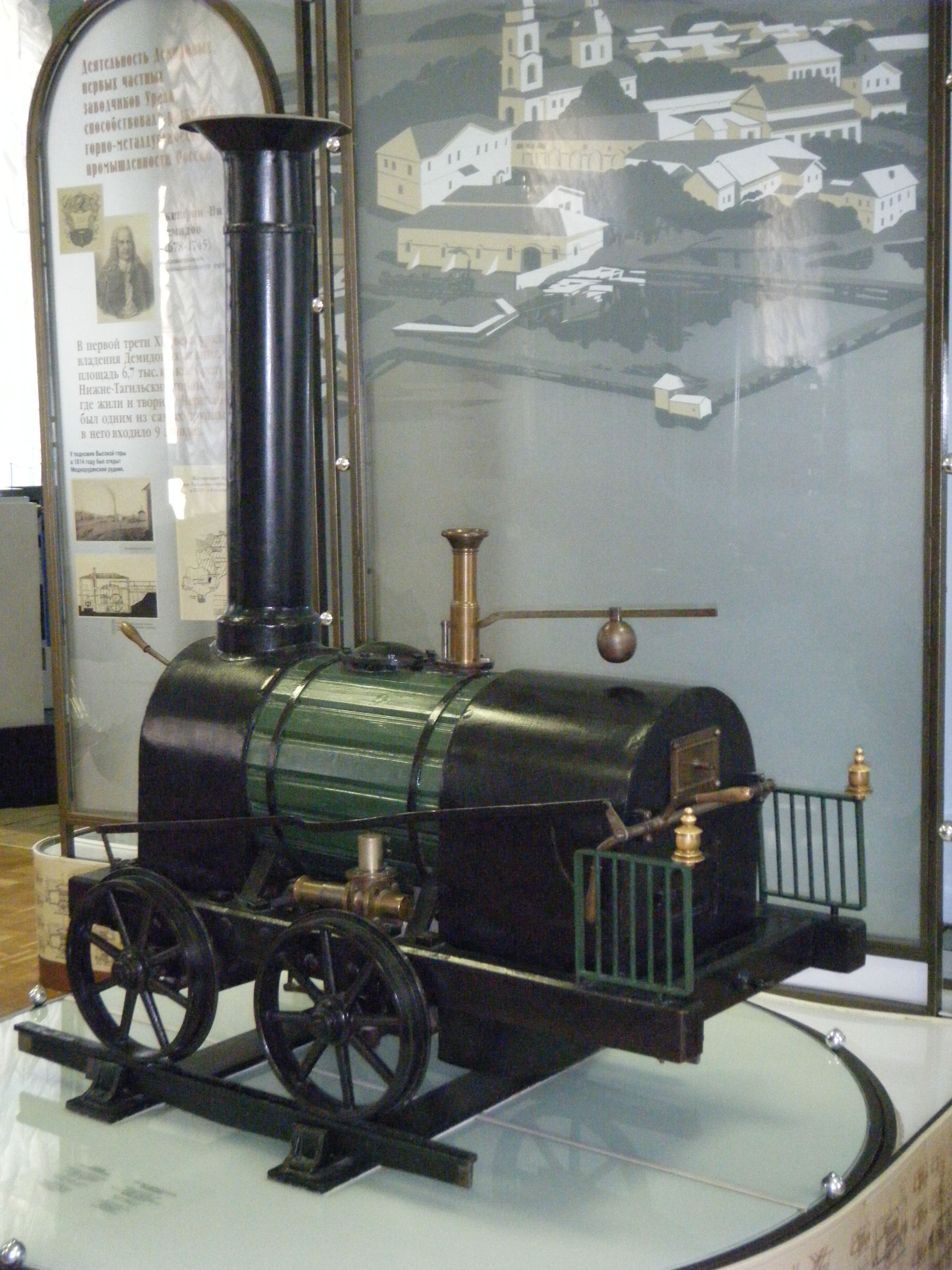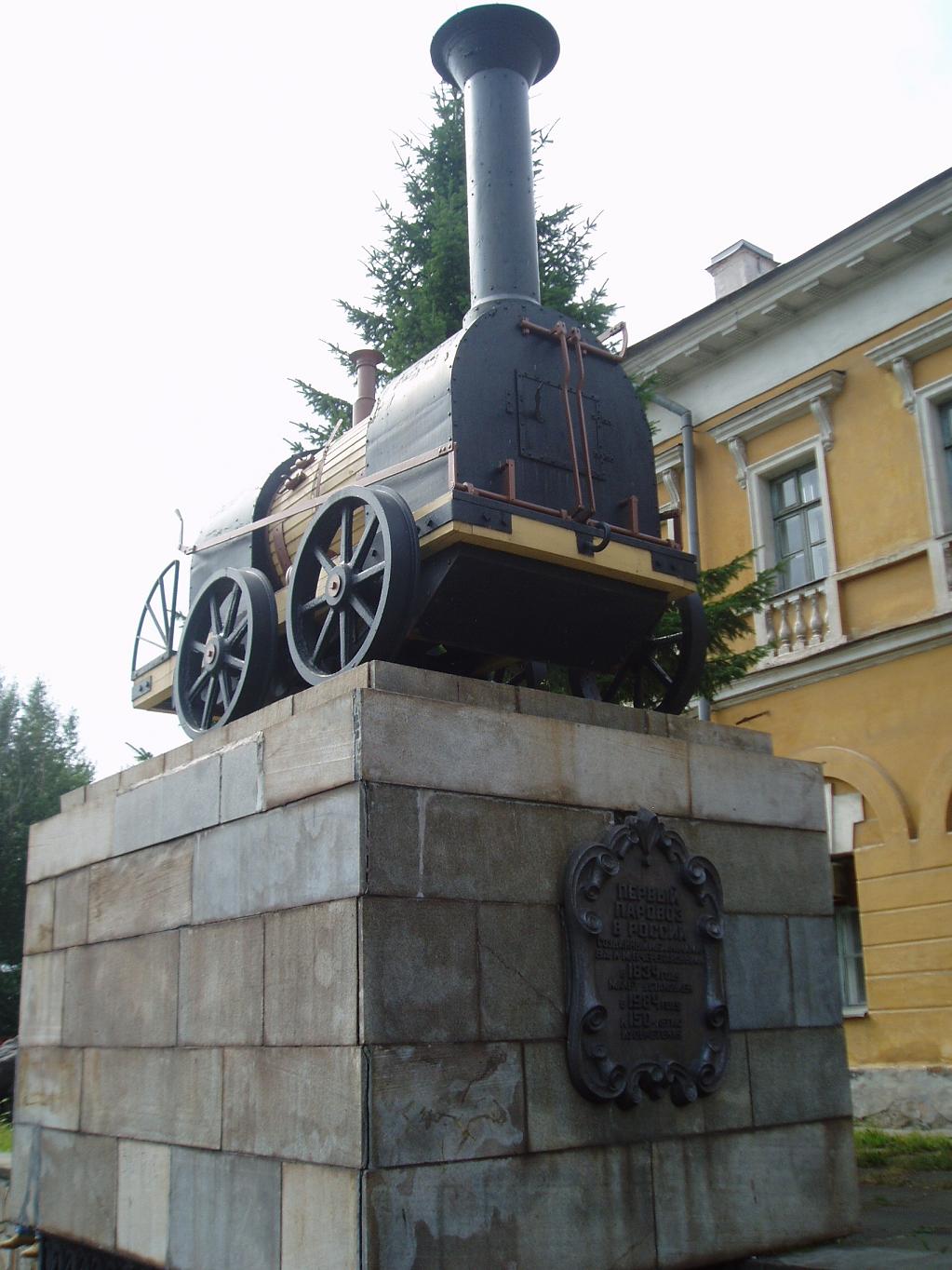Yefim Alekseyevich Cherepanov And Miron Yefimovich Cherepanov on:
[Wikipedia]
[Google]
[Amazon]

 Yefim Alekseyevich Cherepanov (; 1774 – 1842), and his son Miron Yefimovich Cherepanov (; 1803 – 1849) were
Yefim Alekseyevich Cherepanov (; 1774 – 1842), and his son Miron Yefimovich Cherepanov (; 1803 – 1849) were


 Yefim Alekseyevich Cherepanov (; 1774 – 1842), and his son Miron Yefimovich Cherepanov (; 1803 – 1849) were
Yefim Alekseyevich Cherepanov (; 1774 – 1842), and his son Miron Yefimovich Cherepanov (; 1803 – 1849) were Russia
Russia, or the Russian Federation, is a country spanning Eastern Europe and North Asia. It is the list of countries and dependencies by area, largest country in the world, and extends across Time in Russia, eleven time zones, sharing Borders ...
n inventor
An invention is a unique or novel device, method, composition, idea, or process. An invention may be an improvement upon a machine, product, or process for increasing efficiency or lowering cost. It may also be an entirely new concept. If an ...
s and industrial engineers
Industrial may refer to:
Industry
* Industrial archaeology, the study of the history of the industry
* Industrial engineering, engineering dealing with the optimization of complex industrial processes or systems
* Industrial city, a city dominate ...
. They were serfs
Serfdom was the status of many peasants under feudalism, specifically relating to manorialism and similar systems. It was a condition of debt bondage and indentured servitude with similarities to and differences from slavery. It developed dur ...
of the Demidov
The Demidov family (Russian: Деми́довы), also known as Demidoff or Dimidov, is a prominent Russian nobility, Russian noble family that rose to immense wealth and influence during the 18th and 19th centuries. The Demidovs became a wealth ...
s – a famous family of factory owners.
In 1810s Yefim built a progressive machine-building plant, equipped with a full range of innovative metal-cutting lathe
A lathe () is a machine tool that rotates a workpiece about an axis of rotation to perform various operations such as cutting, sanding, knurling, drilling, deformation, facing, threading and turning, with tools that are applied to the w ...
s (such as screw-cutters, gear-cutting serrating machines and others). From 1822 until his death, Yefim was chief mechanic for all the factories in the town of Nizhny Tagil
Nizhny Tagil ( rus, Нижний Тагил, p=ˈnʲiʐnʲɪj tɐˈgʲil) is a classification of inhabited localities in Russia, city in Sverdlovsk Oblast, Russia, located east of the Boundaries between the continents#Asia and Europe, boundary ...
. Miron was his apprentice and in 1819 was appointed his deputy. Miron became chief mechanic after his father's death.
Innovations
Industrial machinery
The Cherepanovs significantly improved the machinery that had been used in blast-furnace andgold
Gold is a chemical element; it has chemical symbol Au (from Latin ) and atomic number 79. In its pure form, it is a brightness, bright, slightly orange-yellow, dense, soft, malleable, and ductile metal. Chemically, gold is a transition metal ...
-mining industries, iron
Iron is a chemical element; it has symbol Fe () and atomic number 26. It is a metal that belongs to the first transition series and group 8 of the periodic table. It is, by mass, the most common element on Earth, forming much of Earth's o ...
and copper
Copper is a chemical element; it has symbol Cu (from Latin ) and atomic number 29. It is a soft, malleable, and ductile metal with very high thermal and electrical conductivity. A freshly exposed surface of pure copper has a pinkish-orang ...
works, sawmill
A sawmill (saw mill, saw-mill) or lumber mill is a facility where logging, logs are cut into lumber. Modern sawmills use a motorized saw to cut logs lengthwise to make long pieces, and crosswise to length depending on standard or custom sizes ...
s, and flourmills.
Steam engines
The most interesting aspect of the Cherepanovs' work weresteam engine
A steam engine is a heat engine that performs Work (physics), mechanical work using steam as its working fluid. The steam engine uses the force produced by steam pressure to push a piston back and forth inside a Cylinder (locomotive), cyl ...
s which they tried to introduce into industrial production. From 1820, the Cherepanovs built about 20 steam engines that ranged from 2 to 60 hp.
Railroad
In 1833-34 they built the first Russiansteam locomotive
A steam locomotive is a locomotive that provides the force to move itself and other vehicles by means of the expansion of steam. It is fuelled by burning combustible material (usually coal, Fuel oil, oil or, rarely, Wood fuel, wood) to heat ...
. They also built a cast-iron railroad
Rail transport (also known as train transport) is a means of transport using wheeled vehicles running in railway track, tracks, which usually consist of two parallel steel railway track, rails. Rail transport is one of the two primary means of ...
from one of their factories to a copper mine
Mine, mines, miners or mining may refer to:
Extraction or digging
*Miner, a person engaged in mining or digging
*Mining, extraction of mineral resources from the ground through a mine
Grammar
*Mine, a first-person English possessive pronoun
M ...
. Track gauge
In rail transport, track gauge is the distance between the two rails of a railway track. All vehicles on a rail network must have Wheelset (rail transport), wheelsets that are compatible with the track gauge. Since many different track gauges ...
was 5 ft 6 in (1670 mm). In 1835, they built a second locomotive that they sent to Saint Petersburg
Saint Petersburg, formerly known as Petrograd and later Leningrad, is the List of cities and towns in Russia by population, second-largest city in Russia after Moscow. It is situated on the Neva, River Neva, at the head of the Gulf of Finland ...
. Despite the successful performance and operation of their locomotives, the Cherepanovs' invention found no support outside the factory and, subsequently, horse traction replaced their steam locomotive
A steam locomotive is a locomotive that provides the force to move itself and other vehicles by means of the expansion of steam. It is fuelled by burning combustible material (usually coal, Fuel oil, oil or, rarely, Wood fuel, wood) to heat ...
s.

See also
*Russian Railway Museum
The Russian Railway Museum is situated next to Baltiysky railway station in Saint Petersburg. The museum was established in 1978, its current site and exhibition opened to public on 1 November 2017. The museum utilizes the nineteenth century ...
, Saint Petersburg
Saint Petersburg, formerly known as Petrograd and later Leningrad, is the List of cities and towns in Russia by population, second-largest city in Russia after Moscow. It is situated on the Neva, River Neva, at the head of the Gulf of Finland ...
* Stephenson's Rocket
Stephenson's ''Rocket'' is an early steam locomotive of 0-2-2 wheel arrangement. It was built for and won the Rainhill Trials of the Liverpool and Manchester Railway (L&MR), held in October 1829 to show that improved locomotives would be m ...
* Planet (locomotive)
''Planet'' was an early steam locomotive built in 1830 by Robert Stephenson and Company for the Liverpool and Manchester Railway.
History
The ninth locomotive built for the L&MR, it was Stephenson's next major design change after the ''Rock ...
* Bury Bar Frame locomotive
The Bury Bar Frame locomotive was an early type of steam locomotive, developed at the Liverpool works of Edward Bury and Company, later named Bury, Curtis, and Kennedy in 1842. By the 1830s, the railway locomotive had evolved into three basic ...
References